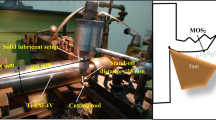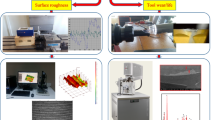Abstract
This study analysed the permeation mechanism of lubricants and the influence of lubrication action on the cutting force and cutting temperature in the machining process using a minimum quantity lubrication (MQL) approach. Friction, wear, and cutting tests were carried out on 022Cr17Ni12Mo2 stainless steel under the conditions of dry cutting (DRY), MQL, and cold wind (COL), respectively. Results showed that, for the YG8/022Cr17Ni12Mo2 friction pairs, the friction coefficients were reduced by 44.8 and 11.3 % on average under COL conditions compared with those under DRY and MQL conditions, separately. The wear rate of the stainless steel under MQL conditions was 86.3 and 87.2 % less than those under DRY and COL conditions, respectively. The particles under MQL conditions can generate thin oxide films with the effect of reducing friction on the friction surface at a high cutting speed with high efficiency. In the low-speed cutting process, the wear losses of all the flank faces were small, felt wear was mainly found under DRY and COL conditions, accompanied by abrasive wear and oxidative wear; while abrasive wear and oxidative wear primarily happened to those tools under MQL conditions, together with felt wear. By contrast, in the high-speed cutting process, felt wear and diffusive wear play the same important role in overall tool wear under DRY and COL conditions while diffusive wear, oxidative wear, and abrasive wear contribute equally to the wear of tools under MQL conditions; the tool tips were not as severely worn.
Similar content being viewed by others
References
Maranhao C, Davim JP (2010) Finite element modelling of machining of AISI 316 steel:numerical simulation and experimental validation. Simul Model Pract Theory 18(2):139–156
Nasr MNA, Ng EG, Elbestawi MA (2007) Modelling the effects of tool-edge radius on residual stresses when orthogonal cutting AISI 316L. Journal of Machine Tools & Manufacture 47(2):401–411
Munoz-Sanchez A, Canteli JA, Cantero JL, Miguélez MH (2011) Numerical analysis of the tool wear effect in the machining induced residual stresses. Simul Model Pract Theory 19(2):872–886
Umbrello D, Saoubi RM, Outeiro JC (2007) The influence of Johnson—Cook material constants on finite element simulation of machining of AISI 316L steel. Journal of Machine Tools & Manufacture 47(3–4):462–470
Geng-Huang HE, Zhang SQ, Zou LL (2015) Study on the high efficiency turning technology of difficult-to-machine material stainless Steel and its Cutter. Modular Machine Tool & Automatic Manufacturing Technique 11(11):8–10
Wu QZ, Li JH (2015) Fatigue life prediction of notched specimen for 022Cr17Ni12Mo2 stainless steel. Materials for Mech Eng 39(12):55–62
Wang TJ, Zhou JH (2009) Cutting process of 1 Cr18Ni9Ti stainless steel. Tool Engineering 43(7):63–67
Feng CB, Xie GZ, Sheng XM (2013) Process test research on stainless steel in ultra-high speed grinding. China Mech Eng 24(3):322–326
Wang ZG, Yang WY, Yan L (2012) Experimental reserrch on machining hardening of OCr18Ni9 austenite stainless steel. China Mech Eng 23(24):2950–2955
Xavior MA, Adithan M (2009) Determining the influence of cutting fluids on tool wear and surface roughness during turning of AISI 304 austenitic stainless steel. J Mater Process Technol 209(2):900–909
Wan M, Zhang WH, Qin GH (2007) Efficient calibration of instantaneous cutting force coefficients and runout parameters for general end mills. Journal of Machine Tools & Manufacture 47(11):1767–1776
Yan LT, Yuan SM, Liu Q (2010) Tool wear and chip formation in green machining of high strength steel. Journal of Mechanical Engineering 46(9):187–192
Li B, Hullender D, DiRenzo M (1998) Nonlinear induced disturbance rejection in inertial stabilization systems. IEEE Trans Control Syst Technol 6(3):421–427
Kennedy PJ, Kennedy RL (2003) Direct versus indirect line of sight ( LOS) stabilization. IEEE Transactions on Control System Technology 11(1):3–15
Qi BY, He N, Li L, Zhao W, Bian R (2010) Cryogenic minimum quantity lubrication technology and its action mechanism. Mechanical Science and Technology for Aerosp Eng 29(6):826–835
Schulz H, Abele E, He L (2010) High speed machining theory and application. science press, Beijing
Liao YS, Lin HM (2007) Mechanism of minimum quantity lubrication in high-speed milling of hardened steel. Journal of Machine Tools & Manufacture 47(11):1660–1666
Chen DC, Suzuki YS, Sakai KT (2000) Effect of using small amount of lubricating oil cold air cooling on the quality of machining surface of high-silicon aluminum alloy. Chinese Journal of Mechanical Engineering 36(11):70–74
Ma LJ, Wang GC, Zhang CY (2009) Application of minimum quantity lubricant in vibration drilling. Mech Eng 45(1):223–227
Su Y, He N, Li L (2010) Effect of refrigerated air cutting on tool wear in high-speed cutting of difficult-to-cut materials. J Tribol 30(5):485–490
Maruda RW, Krolczyk GM, Feldshtein E (2016) A study on droplets sizes, their distribution and heat exchange for minimum quantity cooling lubrication (MQCL). Int J Mach Tools Manuf 100:81–92
Maruda RW, Legutko S, Krolczyk GM, Hloch S, Michalski M (2015) An influence of active additives on the formation of selected indicators of the condition of the X10CrNi18-8 stainless steel surface layer in MQCL conditions. Int J Surf Sci Eng 9(5):452–465
Maruda RW, Stanislaw L, Krolczyk GM, Raos P (2015) Influence of cooling conditions on the machining process under MQCL and MQL conditions. Teh Vjesn 22(4):965–970
Hadad M, Sharbati A (2016) Thermal aspects of environmentally friendly-MQL grinding process. Procedia CIRP 40:509–51528
Silva RBD, Vieira JM, Cardoso RN (2011) Tool wear analysis in milling of medium carbon steel with coated cemented carbide inserts using different machining lubrication/cooling systems. Wear 271(9):2459–2465
Duchosal A, Werda S, Serra R (2015) Numerical modeling and experimental measurement of MQL impingement over an insert in a milling tool with inner channels. Int J Mach Tools Manuf 94:37–47
Lacalle LN, Angulo C, Lamikiz A, Sánchez JA (2006) Experimental and numerical investigation of the effect of spray cutting fluids in high speed milling. J Mater Process Technol 172(1):11–15
Tang LH, Gao CX, Huang JL, Hao S, Chang WC (2015) Empirical models for cutting forces in finish dry hard turning of hardened tool steel at different hardness levels. Int J Adv Manuf Technol 76(1–4):691–703
Tang LH, Gao CX, Huang JL, Hao S, Lin XJ (2015) Experimental investigation of surface integrity in finish dry hard turning of hardened tool steel at different hardness levels. Int J Adv Manuf Technol 77(9–12):1655–1669
Yan KH, Li CS, Zu CY (2005) Application of compounded lubrication with mist cooling and coated cutter technology to machining. Materials For Mech Eng 29(7):17–24
Jiang ZH, Wang LL, Shi L (2014) Study on tool wear mechanism and characteristics of carbide tools in cutting Ti6Al4V. Chinese Journal of Mechanical Engineering 50(1):178–184
Author information
Authors and Affiliations
Corresponding author
Rights and permissions
About this article
Cite this article
Chuangwen, X., Ting, X., Huaiyuan, L. et al. Friction, wear, and cutting tests on 022Cr17Ni12Mo2 stainless steel under minimum quantity lubrication conditions. Int J Adv Manuf Technol 90, 677–689 (2017). https://doi.org/10.1007/s00170-016-9406-6
Received:
Accepted:
Published:
Issue Date:
DOI: https://doi.org/10.1007/s00170-016-9406-6




